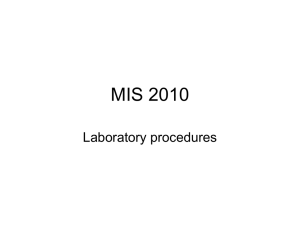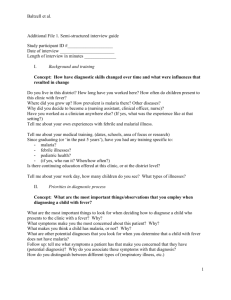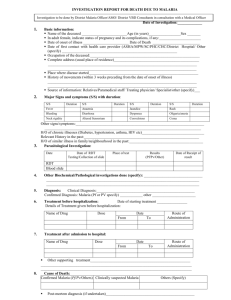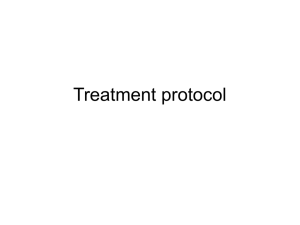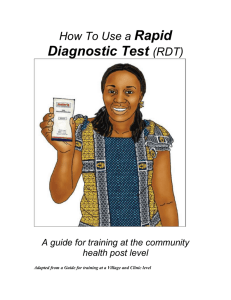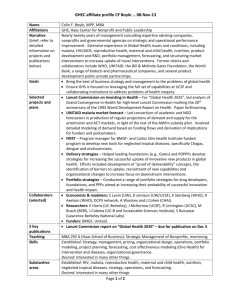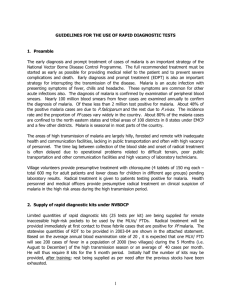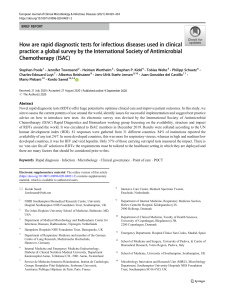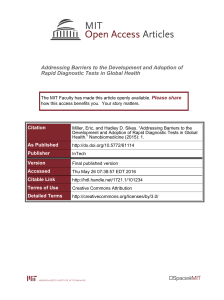Landscape and Analysis of USAID Supported Products
advertisement
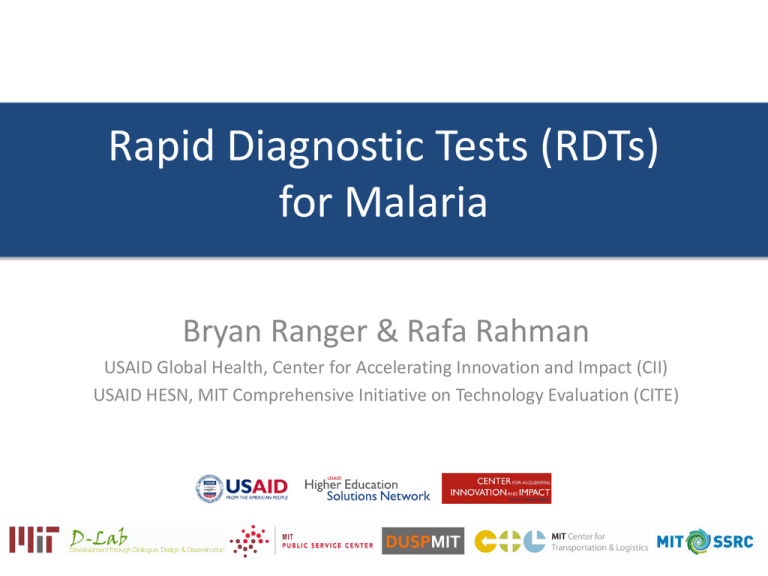
Rapid Diagnostic Tests (RDTs) for Malaria Bryan Ranger & Rafa Rahman USAID Global Health, Center for Accelerating Innovation and Impact (CII) USAID HESN, MIT Comprehensive Initiative on Technology Evaluation (CITE) Outline • Introduction to HESN, CITE, and CII • Our work • Future Comprehensive Initiative for Technology Evaluation (CITE) • Evaluate technological solutions to development challenges and poverty relief. suitability • “Consumer reports” for development. 3S sustainability scalability Comprehensive Initiative Initiative for for Comprehensive Technology Evaluation (CITE) Technology Evaluation (CITE) Student interns working with Mercy Corps, UNICEF, USAID, etc. Spring class with 14 students Product Catalog Scientific Knowledge Case Studies Product Evaluation Pipeline Define/Refine Comprehensive 3S Methodology Evaluation Reports Conduct 3S Evaluation Design Challenges Suitability Design Principles Scalability Design Principles Sustainability Design Principles Source: Jarrod Goentzel, CITE Preliminary catalog developed in spring by students Pilot in Uganda with 3 students Goal: promote innovative, business‐minded approaches to accelerate impact against some of the world’s most important health challenges. • Identify state of the art practices • Catalyze innovation • Scaling for impact Product Introduction Lifecycle & 3S Model Development Introduction Scale Problem Definition and Vision suitability Product Design Research and Development Operational Planning for Uptake Launch and Uptake Execution 3S sustainability scalability Define Technology Focus Defined which technology categories we will focus on: • • Rapid diagnostic tests (RDT’s) for malaria Family planning Considerations for narrowing technology categories: • Mutual interest between CITE and CII • Available information (in-house expertise, CITE intern placement) • USAID strategic focus areas • UN and WHO goals • Suitable for evaluation Problem Definition & Product Design Case Studies Development Introduction Scale Problem Definition and Vision suitability Product Design Research and Development Operational Planning for Uptake 3S sustainability scalability Launch and Uptake Execution • Case Study 1: Malaria Rapid Diagnostic Tests • Case Study 2: Intrauterine Devices Part 1: Defining the Problem Part 1: Defining the Problem • Prevalence – Geographic – At-risk populations • Financial Burden • Pathology – – – – – Plasmodium species Spread and life cycle Symptoms Reasons for at-risk groups Treatment • Diagnosis – Diagnostic Technologies • • • • Microscopy Fluorescence Microscopy Polymerase Chain Reaction Serology Prevalence Part 1: Defining the Problem Source: CDC, 2008 Benefits of a Good Diagnostic Test • • • • • Timely and appropriate treatment Decrease chance of transmission Reduced exposure to unnecessary drugs Conserve drugs Lessen likelihood of drug resistant species development Diagnostic Pipeline Part 1: Defining the Problem Source: UNITAID Microscopy Part 1: Defining the Problem Parasite Presence, Species, Density Source: CDC Introduction of Rapid Diagnostic Tests Part 1: Defining (RDTs)the Problem • • • • • Immunochromatographic strip (ICS) Suitable to low-resource settings Technology developed in 1981 First product in 1994 Increased funding and uptake in early 2000s Use of Diagnostics Part 1: Defining the Problem Proliferation of RDT Industry Part 1: Defining the Problem Over 200 Products • Confusing array • Mistrust due to sensitivity concerns WHO Product Testing Lot Testing End-User Testing How It Works CONTROL Part 1: Defining the Problem SAMPLE ADDITION TEST BAND BAND IMMUNOCHROMATOGRAPHIC STRIP (ICS) TEST CONTROL TEST CONTROL GOLD PARTICLE OR LIPOSOME LABEL TEST CONTROL TEST CONTROL TEST CONTROL TEST CONTROL Product Design Factors Antigen Selection Sensitivity & Specificity Stability Product Design Factors Speed Cost Ease-ofuse 1. Antigen Selection Part 1: Defining the Problem Antigen HRP-2 pLDH X X Aldolase Species P. falciparum specific Pan-specific (all species) X P. vivax specific X Source: UNICEF X 2. Sensitivity & Specificity Part 1: Defining the Problem • Sensitivity – percent positive detection out of true-positive sample • Specificity – percent negative detection out of true-negative sample 3. Cost Part 1: Defining the Problem • Decrease – 2006: $0.65 to $2.50 • Pan-specific cost 40% more than P. falciparum-only – 2010: $0.51 for P. falciparum-specific and $0.69 for combination – Currently: ~$0.45 for P. falciparum, $0.65 for combination – Some bids below $0.30 • Manufacturing & packaging Source: Mary Anne Fisher, BD 4. Ease-of-use Part 1: Defining the Problem • Dipstick, Card, Cassette, Hybrid Source: Mary Anne Fisher, BD Source: A. Moody 5. Speed Part 1: Defining the Problem • 15-20 minutes • Balance speed and sensitivity • End-user issues with timing 6. Stability Part 1: Defining the Problem • Excellent compared to other methods • Heat, humidity concerns “Although receiving significant attention, stability has ‘turned out to be a complete non-issue.’” -Dr. Larry Barat, PMI Antigen Selection ` -3 currently in use -HRP-2 detecting is most sensitive Sensitivity & Specificity Stability -Previous heat and humidity concerns -Future products might benefit from higher sensitivity at low parasitemia -Not a major issue Product Design Factors Cost Speed -Declining costs -Has remained ~15 minutes -May not be sustainable Ease-ofuse -Trend from dipsticks to cassettes Remaining Challenges Part 1: Defining the Problem • • • • Adherence to test results Unaddressed populations Non-falciparum detection quality Persisting antigenemia Conclusion Part 1: Defining the Problem Development Introduction Scale Problem Definition and Vision suitability Product Design Research and Development Operational Planning for Uptake 3S sustainability scalability Launch and Uptake Execution RDTs fill suitability gap in malaria diagnostics Future Part 1: Defining the Problem New gold standard? Landscape & Analysis Project ` Development Introduction Scale Problem Definition and Vision suitability Product Design Research and Development Operational Planning for Uptake 3S sustainability scalability Launch and Uptake Execution • Phase 1: Collect data on selected technological categories • Phase 2: Perform analysis (coverage and uptake plots to illustrate product introduction and scale, etc.) Data Collection: Summary of Sources • WHO – World Malaria Report (includes country profiles) – Evaluations of RDT Products – Roll Back Malaria Initiative • President’s Malaria Initiative (PMI) & USAID Deliver Project – Malaria Operational Plans, Country Profiles • The Global Fund to Fight AIDS, Tuberculosis and Malaria • UNICEF (in progress) WHO Data (From Malaria Report 2012) Possible metrics to analyze coverage • Questions to consider: – How has coverage of RDT changed over time? – How has scale-up of RDT coincided with microscopy? WHO Data (From Malaria Report 2012) Total Cases Confirmed by either RDT or Microscopy by year (African PMI-focus countries) 12,000,000 10,000,000 Number of Cases 8,000,000 Total Cases confirmed with RDT (PMI-focus countries) 6,000,000 Total Cases confirmed with microscopy (PMI-focus countries) 4,000,000 = Start of PMI involvement 2,000,000 0 1998 2000 2002 2004 2006 Year 2008 2010 2012 WHO Data (From Malaria Report 2012) Cambodia Sierra Leone 120 80 70 100 60 Percent Percent 80 60 40 50 40 30 20 20 0 2000 10 2002 2004 2006 Year 2008 2010 2012 0 1998 2000 2002 2004 2006 2008 2010 Year • Conclusion: RDTs appear to be replacing microscopy in some countries 2012 WHO Data (From Malaria Report 2012) Ghana 60 60 50 50 40 40 Percent Percent Angola 30 30 20 20 10 10 0 2004 2005 2006 2007 2008 Year 2009 2010 2011 2012 0 2002 2004 2006 2008 2010 Year = Start of PMI involvement • Conclusion: Similar trend in some PMI-focus countries, but more future time points needed 2012 WHO Data (From Malaria Report 2012) Madagascar Niger 100 120 90 100 80 70 Percent Percent 80 60 40 50 40 30 20 20 0 1998 60 10 2000 2002 2004 2006 2008 2010 2012 0 2002 2004 2006 2008 2010 Year Year = Start of PMI involvement • Conclusion: Rapid uptake of RDTs in many countries 2012 WHO Data (From Malaria Report 2012) Burundi 90 80 70 Percent Percent 60 50 40 30 20 10 0 1998 2000 2002 2004 2006 2008 2010 2012 100 90 80 70 60 50 40 30 20 10 0 2004 Liberia 2005 2006 2007 2008 2009 2010 2011 Year Year = Start of PMI involvement • Conclusion: Despite general trends, every country has its own story to tell 2012 Conclusions from WHO Data Development Introduction Scale Problem Definition and Vision suitability Product Design Research and Development Operational Planning for Uptake 3S sustainability Launch and Uptake Execution RDTs seem to be more scalable, and in some places replacing older technology scalability Procurement of RDTs Possible metric to analyze coverage • Questions to consider: – How has coverage of RDT changed over time? – What products have been procured? – Have countries started procuring RDTs for themselves? Procurement of RDTs 70,000,000 7,000,000 60,000,000 6,000,000 50,000,000 5,000,000 40,000,000 4,000,000 30,000,000 3,000,000 20,000,000 2,000,000 10,000,000 1,000,000 0 2005 2006 2007 2008 2009 Year 2010 2011 0 2012 Number of Malaria Cases Confirmed by RDT [WHO] Amount Procured Total Procurement of RDTs (African PMI-focus Countries) 2013 Procurement of RDTs – Angola Example Procurement - Angola 1,800,000 1,600,000 1,400,000 Procurement 1,200,000 1,000,000 PMI 800,000 Global Fund Angola National Malaria Program 600,000 400,000 200,000 0 2005 2006 2007 2008 2009 2010 2011 2012 2013 Year • Angola has begun to procure RDTs on its own, with procurement plans up to 2015 [Source: Angola Global Fund Round 10 Proposal] Procurement of RDTs - Products Number of Each RDT Product Purchased by Global Fund (Africa PMI-Focus Countries, All years) 50,000,000 45,000,000 Total Procured (All Years) 40,000,000 35,000,000 30,000,000 25,000,000 20,000,000 15,000,000 10,000,000 5,000,000 0 Orgenics Clearview Orchid Paracheck ICT SD Bioline Premier FirstResponse AccessBio CareStart CTK OnSite RDT Product Source: Global Fund Procurement of RDTs – Amount Spent Amount Spent on RDT Procurement by Global Fund (African PMI-focus countries) 14,000,000 12,000,000 Amount (USD) 10,000,000 8,000,000 6,000,000 4,000,000 2,000,000 0 Country Source: Global Fund Procurement of RDTs Average ± SD (min, max) Difference between purchase order date and actual delivery date Difference between scheduled delivery date and actual delivery date 129 ± 87 3 ± 82 (1,475) (-233,278) • Large variance in time between scheduled and actual delivery date Source: Global Fund Conclusions from Procurement Data Development Introduction Scale Problem Definition and Vision suitability Product Design Research and Development Operational Planning for Uptake 3S sustainability scalability Launch and Uptake Execution Scalability: No lag between RDT procurement and confirmed cases Sustainability: Some countries have started to procure RDTs Potential issues: many products (no standard), large variance in time between scheduled and actual delivery Overall Conclusions Development Introduction Scale Problem Definition and Vision suitability Product Design Research and Development Operational Planning for Uptake 3S sustainability Launch and Uptake Execution • Explored suitability, scalability and sustainability of RDTs [CITE] • Considered our work in context of product uptake timeline [CII] scalability Future Work • Combine our case study projects to create powerful evaluation tool for RDTs • Possible format: RDT Product Product A Product B Price Antigens Detected Sensitivity at ____ parasites/ ul Specificity at ____ parasites/ ul Format Speed Stability Number of units procured Countries with implement -ation Acknowledgements • • • • • USAID Joe Wilson Callie Raulfs-Wang Dave Milestone Larry Barat Amit Mistry CITE • Christine Pilcavage • Derek Brine Becton Dickinson • Mary Anne Fisher
